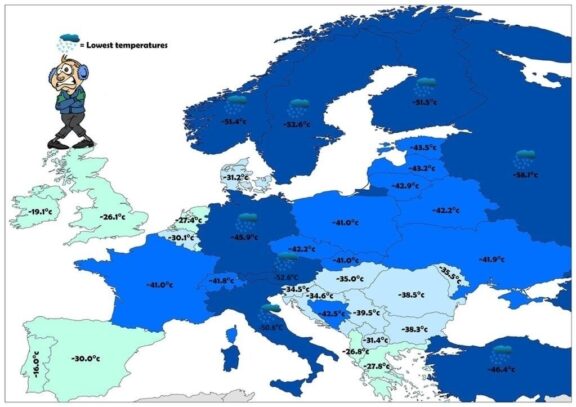In this article we will see The Lowest Temperatures Recorded in Europe on the map.

“In fact, there is no cold … According to physics laws, in real life, we give the name ‘coldness’ to ‘absence of heat’ … There is no such thing as cold … It is just a word we produce to describe what we feel in the absence of heat.”
We started with the words of Einstein. After the highest temperatures recorded in Europe, we are now at the lowest temperatures officially registered. The lowest temperatures in Europe are recorded in countries on the map. The lowest recorded low temperature is estimated to be in Russia’s ‘European territory’, as can be estimated. The lowest temperature is recorded in Ireland.
As you can see on the map, you can see the lowest temperatures and the locations where these temperatures are recorded in the table below.
| COUNTRY | RECORD | LOCATION | YEAR |
|---|---|---|---|
| Russia | -58.1°C | Ust’ Shchugor | 1978 |
| Sweden | -52.6°C | Vuoggatjålme | 1966 |
| Finland | -51.5°C | Kittilä | 1999 |
| Norway | -51.4°C | Karasjok | 1886 |
| Italy | -50.6°C | Busa Riviera | 2022 |
| Austria | -52.6°C | Grünloch | 1932 |
| Turkey | -46.4°C | Van | 1990 |
| Germany | -45.9°C | Funtensee | 2001 |
| Estonia | -43.5°C | Jõgeva | 1940 |
| Latvia | -43.2°C | Daugavpils | 1956 |
| Lithuania | -42.9°C | Utena | 1956 |
| Bosnia and Herzegovina | -42.5°C | Igman | 1963 |
| Belarus | -42.2°C | Slavnom | 1940 |
| Czech Republic | -42.2°C | Litvínovice | 1929 |
| Ukraine | -41.9°C | Luhansk | 1935 |
| Switzerland | -41.8°C | La Brévine | 1987 |
| France | -41.0°C | Mouthe | 1985 |
| Poland | -41.0°C | Siedlce | 1940 |
| Slovakia | -41.0°C | Vígľaš-Pstruša | 1929 |
| Serbia | -39.5°C | Karajukica Bunari | 1985 |
| Romania | -38.5°C | Bod | 1942 |
| Bulgaria | -38.3°C | Tran | 1947 |
| Iceland | -37.9°C | Grímsstaðir | 1918 |
| Moldova | -35.5°C | Brătușeni | 1963 |
| Hungary | -35.0°C | Görömbölytapolca | 1940 |
| Croatia | -34.6°C | Gračac | 2003 |
| Slovenia | -34.5°C | Babno Polje | 1968 |
| Montenegro | -32.0°C | Rozaje | – |
| Macedonia | -31.5°C | Berovo | 1954 |
| Denmark | -31.2°C | Thisted Municipality | 1982 |
| Belgium | -30.1°C | Rochefort | 1940 |
| Spain | -30.0°C | Calamocha Airport | 1963 |
| Greece | -27.8°C | Ptolemaida | 1963 |
| Netherlands | -27.4°C | Winterswijk | 1942 |
| Albania | -26.8°C | Sheqeras | – |
| United Kingdom | -26.1°C | Newport | 1982 |
| Luxembourg | -24.6°C | Wiltz | – |
| Ireland | -19.1°C | Markree Castle | 1881 |
| Portugal | -16.0°C | Penhas da Saúde | 1954 |
Winter months are now colder in Europe…
In The Lowest Temperatures Recorded in Europe post, we talked about global warming. Global warming in Europe is the main cause of the hotter summers, as well as the harder winters.
It is known that when the winds around the Arctic region slow down, the cold air in the pole is released, and in some parts of the northern hemisphere, it normally leads to cold weather. Research has shown that this has been felt more in the last 40 years. It is obvious that extreme colds in Europe and Russia are related to this.
This is the first research to show that the winter in Europe is cooling down because of the change of winds in the stratosphere. But it is still a matter of research, and it is a good example of how climate change can change the polar regions and how it can affect the world. There is no certainty that the climate will change since the weather is getting hotter, it can also cool down.
Normally in the winter months, the cold air is locked by the winds that are lifting kilometers high in the Arctic region. When these winds slow down, the extreme cold air goes down to the latitudes (like Europe). This has been seen in recent years. This is one of the greatest causes of cooling since 1990’s.
How far are we to the danger?
Currently, there is no great danger, but when the research continues to progress in this way, it suggests that big dangers are waiting for us in 40-50 years. Excessive consumption of greenhouse gases, gasoline, coal, etc., affects the glaciers. The answer to whether we can take precautions is simple. It’s not easy, but we can get rid of it. Can the use of the materials we just talked about be reduced? Natural gas has begun to be widely used and we can say that the oil is gradually turning over.
The use of non-petroleum water in vehicles, as well as vehicles powered by the sun, is on the agenda. If the use of such things is widespread, the danger can be prevented from growing.
You can read more about the highest temperature recorded in Europe and the coldest countries in the world.